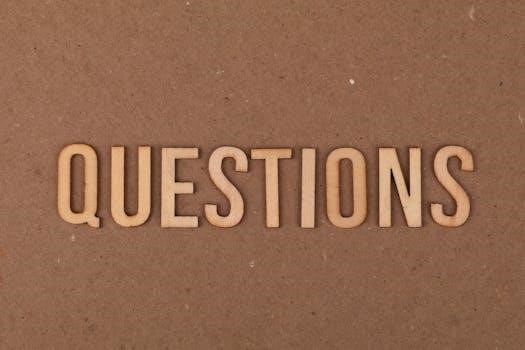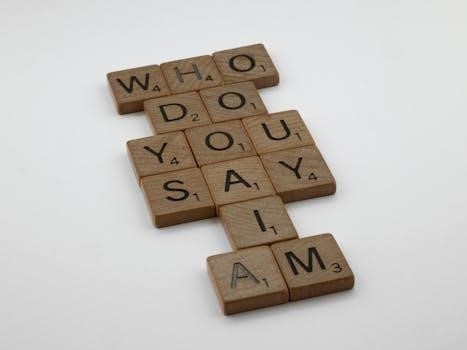These worksheets are invaluable resources for learning English grammar, focusing on ‘wh’ questions. They provide practical exercises, including fill-in-the-blanks and multiple-choice options, to help students master question formation and usage.
What are WH Questions?
WH questions are a fundamental aspect of English grammar, used to gather specific information. These questions begin with question words such as ‘who,’ ‘what,’ ‘where,’ ‘when,’ ‘why,’ and ‘how.’ They are essential for engaging in meaningful conversations and understanding the world around us. Mastering WH questions is crucial for both native and non-native English speakers. They enable us to ask for details about people, objects, places, times, reasons, and manners. Understanding the nuances of each question word is key to formulating accurate and appropriate questions. These questions are not just for seeking basic information but also for delving into deeper understanding and analysis. For instance, ‘why’ questions encourage critical thinking, while ‘how’ questions explore processes and methods. Worksheets focusing on these questions are designed to provide comprehensive practice, helping learners identify and use them correctly. By practicing WH questions, students gain better communicative skills and confidence in their ability to express themselves clearly and effectively. They form the building blocks for more complex question structures and are integral to everyday communication.

Types of WH Questions
WH questions encompass several types, each serving a distinct purpose. These include questions starting with ‘who’, ‘what’, ‘where’, ‘when’, ‘why’, and ‘how’, allowing for a wide range of inquiries.
‘Who’ Questions
‘Who’ questions are specifically designed to inquire about people. They seek to identify the person or persons involved in an action or situation. These questions are fundamental in understanding the human element within a narrative or event. For example, ‘Who ate the cake?’ aims to find the individual responsible for eating the cake. ‘Who has the key?’ asks about the person possessing the key. Worksheets that provide practice with ‘who’ questions can help students differentiate between different types of questions and improve their overall understanding of English grammar. These exercises often include fill-in-the-blank tasks and multiple-choice options, making them suitable for learners at various levels. By mastering ‘who’ questions, students improve their ability to ask and understand questions about people in different situations, enhancing their communication skills. These questions are an essential component of everyday interactions. They help establish the identities of people involved in discussions and events.

‘What’ Questions
‘What’ questions are used to inquire about things, objects, actions, or ideas. They are versatile and can be used in many different contexts. For example, ‘What did you do yesterday?’ seeks information about past actions, while ‘What do you like best?’ asks about preferences. These types of questions are essential for gathering specific details about a topic. Worksheets focusing on ‘what’ questions often include various exercises, such as fill-in-the-blanks, multiple-choice tasks, and question formation activities. These exercises aim to help students practice using ‘what’ in different scenarios, enhancing their comprehension and ability to ask questions effectively. Understanding ‘what’ questions is crucial for daily conversations and academic discussions. They help students to clarify situations, seek specific information, and explore various aspects of a topic. Mastering these questions boosts their overall English language proficiency.
‘Where’ Questions
‘Where’ questions are specifically designed to ask about locations, places, or positions. They are essential for understanding spatial relationships and directions. Examples include questions like, “Where is the key?” or “Where do you live?”. Worksheets for ‘where’ questions often include a variety of practice exercises to help students become comfortable using this specific question word. These activities may include fill-in-the-blank exercises, where students complete sentences with the correct ‘where’ question. There may be picture-based exercises, where students have to ask or answer ‘where’ questions based on visuals. These types of questions are critical for navigating daily life, understanding directions, and discussing locations in a clear and concise manner. Practice with ‘where’ questions improves overall communication skills and helps students understand the context of where an object, person, or event is located.
‘When’ Questions
‘When’ questions are used to ask about time, occasions, or moments. They are crucial for understanding schedules, deadlines, and sequences of events. Examples of ‘when’ questions are⁚ “When is the party?” or “When do you wake up?”. Worksheets focusing on ‘when’ questions often provide varied practice, such as asking students to complete sentences with the correct ‘when’ question word, or providing a picture and having students ask about when an event happened. This practice is essential for helping students understand the timing of events and express themselves clearly. These worksheets ensure learners are prepared to use ‘when’ questions correctly in a range of situations. Furthermore, learning ‘when’ questions is vital for everyday conversations, planning activities, and understanding narratives that involve time-related details.
‘Why’ Questions
‘Why’ questions are used to inquire about reasons, motivations, and causes. Mastering ‘why’ questions is vital for critical thinking and understanding explanations. Worksheets designed for ‘why’ questions often present scenarios and ask students to formulate questions using ‘why’ to uncover the cause. For example, a picture might show a person looking upset, and the student might ask, “Why is she sad?”. These exercises not only reinforce the structure of ‘why’ questions but also encourage students to analyze situations, make inferences, and provide reasoning. The worksheets can also include fill-in-the-blank exercises where students need to insert ‘why’ to form a question, or multiple-choice questions where they choose the correct ‘why’ question for a given situation. This kind of practice is crucial for developing deep understanding and effective communication skills.
‘How’ Questions
‘How’ questions explore the manner, method, or condition of something; These questions are versatile and can be used to inquire about processes, feelings, or measurements. Worksheets targeting ‘how’ questions often involve various formats, such as asking students to describe how something is done. For instance, a worksheet may present a series of steps for baking a cake and ask students to formulate ‘how’ questions based on the process. Or students might be asked to ask ‘how’ to inquire about a person’s feelings. Such exercises help students develop the ability to ask specific questions, which is crucial for clarifying processes and getting detailed information. ‘How’ questions can also be used to inquire about someone’s wellbeing, or to establish the quantity or amount of something. These worksheets offer varied practice to master the use of ‘how’ in different contexts, and help to ensure good communication skills.

Worksheet Formats
Worksheets come in diverse formats, including fill-in-the-blank, multiple choice, and question formation exercises. These formats cater to different learning styles and help reinforce understanding of WH questions.
Fill-in-the-Blank Exercises
Fill-in-the-blank exercises are a common and effective method utilized in WH question worksheets, providing a structured approach to learning. These exercises typically present a sentence with a missing question word, requiring learners to select the appropriate ‘who,’ ‘what,’ ‘where,’ ‘when,’ ‘why,’ or ‘how’ to complete the question correctly. This format is particularly helpful for reinforcing the understanding of each question word’s specific function within a sentence. Furthermore, fill-in-the-blank activities often include a variety of contexts, ensuring that learners understand how to use wh- questions in diverse situations. They help students practice identifying the kind of information a question seeks, whether it’s a person, object, place, time, reason, or manner. Such exercises are fundamental in building a solid foundation for asking and understanding questions in English, enhancing both grammar and comprehension. Moreover, they can be easily adapted for various proficiency levels, making them suitable for a wide range of learners, from beginners to more advanced students. These exercises are an excellent way to reinforce the usage of wh- question words.
Multiple Choice Exercises
Multiple choice exercises are another prevalent component of WH question worksheets, offering a different approach to learning. These exercises present a question or a sentence with a blank, accompanied by several possible question word options. Learners must choose the correct word from the provided choices to complete the question accurately. This format helps in recognizing the nuances of each question word, encouraging careful consideration of context. It also aids in reinforcing the understanding of how each question word seeks a different type of information. Moreover, multiple choice questions are an effective tool for quick assessment and can be easily scored, which makes them convenient for teachers. The exercises also present opportunities for learners to differentiate between similar question words, enhancing their comprehension of wh- questions. The varied options in multiple-choice questions helps students to think critically and to understand how different question words affect the meaning of a sentence. Furthermore, such exercises are a valuable part of the worksheet, providing a practical way to practice and solidify the knowledge of wh- questions.
Question Formation Exercises
Question formation exercises are a crucial part of WH questions worksheets. These exercises challenge learners to create their own questions using the correct question words. They might be presented with a statement and asked to form a question that would elicit that statement as an answer, promoting a deeper understanding of question structure. Such exercises often involve rearranging words into the correct order, thus reinforcing grammatical rules. This type of activity is beneficial because it encourages active learning and requires learners to think critically about the relationship between questions and answers. Furthermore, these exercises can also be structured to focus on specific tenses and situations. By forming their own questions, learners develop a more intuitive grasp of how different question words function. This method helps in practicing not only the use of question words but also the structure of English questions as a whole. The focus is on active recall and application of knowledge, which leads to a more profound understanding.

Benefits of Using WH Questions Worksheets
The use of WH questions worksheets offers numerous benefits for English language learners. They provide structured practice, helping students master the formation and application of question words like ‘who,’ ‘what,’ ‘where,’ ‘when,’ ‘why,’ and ‘how’. Through various exercise formats, these worksheets enhance comprehension and improve the ability to ask and answer questions effectively. Worksheets facilitate active learning, promoting engagement and critical thinking. Students develop a deeper understanding of grammatical structures and improve their overall communication skills. Regular practice with these worksheets helps learners become more confident in using English in everyday conversations. Additionally, these resources are versatile and can be adapted for different learning levels, catering to both beginners and more advanced students. The availability of printable worksheets makes learning accessible and convenient, allowing students to practice both in the classroom and at home. Furthermore, the worksheets provide a tangible way to track progress and identify areas for improvement. They also encourage self-study and independent learning.
